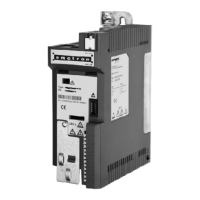10.12. Flying restart circuit
The flying restart function makes it possible to restart a coasting motor on the fly during
operation without speed feedback. Synchronicity between the inverter and the motor is
coordinated so that the transition to the rotating drive is effected without jerk at the time
of connection.
The following description and the listed parameters are valid for the flying
restart circuit of an asynchronous motor.
For information on a flying restart circuit in case of a sensorless control of a
synchronous motor, see chapter "Sensorless control for synchronous motors
(SL-
PSM)".
118
Preconditions
• Drive systems with speed feedback do not need a flying restart circuit because there is
always a jerk-free synchronisation to the feedback speed.
• The flying restart circuit operates safely and reliably in case of drives with high
centrifugal masses. If several motors with different centrifugal masses are connected
to the inverter, the flying restart circuit must not be used.
• The flying restart circuit serves to identify rotating field frequencies of up to maximally
±200 Hz.
Required settings before the flying restart circuit is used:
1.
The motor data must be set correctly.
Motor data
108
2.
The settings for the current controller and the flying restart controller must be
adapted to
the motor. The settings are made automatically if one of the following
optimisations is carried out:
Motor selection from motor catalogue
137
Automatic motor identification (energized)
139
Automatic motor calibration (non-energized)
140
Details
The inverter determines synchronicity by identifying the synchronous rotating field
frequency. The "search" starts in positive direction.
Duration:
• The flying restart process is determined within approx. 0.5 ... 1.5 seconds.
• The duration is influenced by the start frequency 0x2BA1:001 (P718.01).
Setting the function:
1. As starting performance, set the selection "Flying restart circuit [2]" in 0x2838:001
(P203.01).
• Thus, every inverter enable causes a synchronisation to the rotating or standing
drive.
• After the inverter has been enabled, the motor can temporarily start or reverse if
drives with low friction and low mass inertia are used.
• If the inverter is operated with the default settings, no further settings are required
for most applications.
2. If required, adapt the current 0x2BA1:001 (P718.01) and the start frequency
0x2BA1:002 (P718.02) for the flying restart circuit.
• Setting notes can be found in the "Info" column for the respective parameter.

